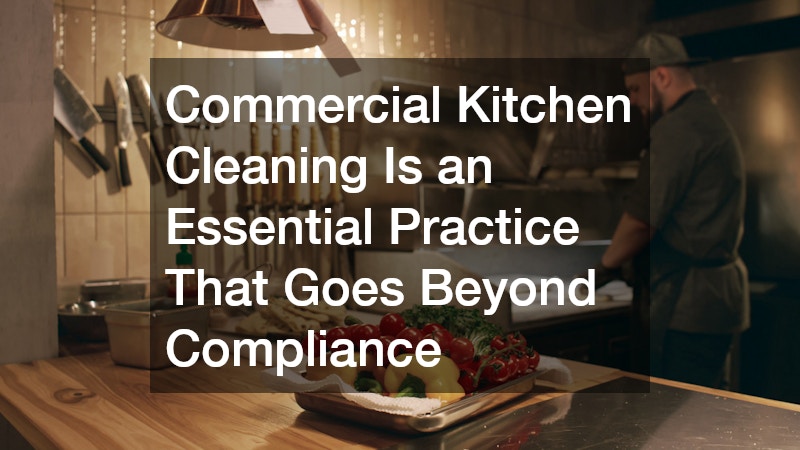Understanding the importance of maintaining a clean and hygienic commercial kitchen is crucial for food safety, customer satisfaction, and compliance with health regulations. This article explores the key aspects of commercial kitchen cleaning, addressing common questions and providing best practices to ensure your kitchen is always at its best. By focusing on these elements, you can foster an environment that prioritizes the quality and safety of your culinary offerings.
Why is Commercial Kitchen Cleaning Important?
Ensuring Food Safety
Kitchen cleaning plays a vital role in preventing contamination and mitigating the risk of foodborne illnesses. A lack of cleanliness can lead to cross-contamination, which is a significant cause of outbreaks linked to commercial kitchens.
Therefore, implementing a rigorous cleaning protocol acts as a safeguard for both your patrons’ health and your business’s reputation.
Preventing the spread of pathogens such as Salmonella and E. coli requires more than just surface-level cleaning. Deep cleaning and sanitization help eliminate harmful bacteria that otherwise thrive in food preparation areas. Proper kitchen hygiene practices set a foundation for a safe working environment that upholds food safety standards.
Furthermore, maintaining proper sanitary conditions ensures that food is prepared in a healthy environment, thereby preserving its quality. The peace of mind that comes from knowing your food is handled hygienically is invaluable for both staff and customers alike. Consistent cleaning measures demonstrate a commitment to excellence in food safety.
Enhancing Customer Experience
A clean kitchen positively impacts customer perception, thus driving customer satisfaction and retention rates. When patrons know that their meals are prepared in a spotless environment, their confidence in your establishment increases. This confidence can translate to positive reviews and repeat business, underscoring the importance of cleanliness.
In a competitive food service industry, differentiation can be challenging, yet a sparkling clean kitchen can set your business apart. Customers are more likely to trust and engage with establishments that visibly prioritize hygiene. In fact, customer loyalty often hinges on the comprehensive experience, where cleanliness is a pivotal part.
Moreover, a clean kitchen directly influences the ambiance and overall dining experience. A kitchen’s state reflects on the entire establishment, affecting the atmosphere customers perceive. By prioritizing a clean environment, you encourage a compulsively attractive space that complements your culinary offerings.
Compliance with Health Regulations
Meeting local and national health standards is essential for avoiding fines and legal issues, making regulatory compliance a fundamental priority. Commercial kitchens are subject to regular inspections, where cleanliness often becomes a decisive factor. Failing to uphold cleaning standards can lead to penalties, impacting the business financially and reputationally.
Health regulations require kitchens to maintain specific hygiene criteria to protect public health and food safety. Adhering to these standards not only prevents legal complications but also projects an image of reliability and professionalism. Regular cleaning ensures that operations align with laws and avoid risks of non-compliance.
Routine cleaning and maintenance also prepare your establishment for surprise inspections by local health authorities. With preparedness, you assuredly convey your dedication to high hygiene standards. Therefore, maintaining a clean environment is both a compliance necessity and a strategic business investment.
What Are the Best Practices for Cleaning a Commercial Kitchen?
Daily Cleaning Routine
Developing a rigorous daily cleaning routine is key to keeping the kitchen environment healthy and safe. Daily tasks typically include wiping down surfaces, sanitizing equipment, and disposing of food waste diligently. Consistency in these practices prevents dirt and bacteria accumulation, ensuring a fresh kitchen for each day.
Implementing a structured cleaning checklist helps manage routine aspects efficiently. Break tasks down into specific timeframes or shifts, allowing for optimal staff engagement and accountability. This structured approach minimizes the likelihood of oversight, affording peace of mind to management and staff alike.
Moreover, fostering a habit of immediate spill and mess cleanliness prevents longer-term issues. Instant cleanup of spills and debris safeguards against slips and deters pests. Instilling this practice amongst staff encourages a proactive cleanliness culture within the kitchen environment.
Deep Cleaning Schedule
Periodic deep cleaning activities are vital for maintaining comprehensive kitchen hygiene, reaching areas that daily routines might overlook. Schedules for deep cleaning should be tailored based on usage frequency and specific kitchen needs. This foresight ensures no stone goes unturned in the pursuit of a spotless kitchen.
Deep cleaning entails the disassembly and scrubbing of equipment, exhaustive floor scrubbing, and thorough ventilation cleaning. Typically scheduled weekly or monthly, these tasks remove accumulated grease, grime, and potential contaminants. Adherence to a planned cycle fortifies your kitchen’s long-term hygiene status.
Moreover, maintaining an organized log of deep cleaning activities enables tracking and adjustment as needed. Regularly updating these records provides clarity on maintenance histories and future needs. With a systematic approach, logistics and cleanliness harmoniously align to support health and operational efficacy.
Choosing the Right Cleaning Products
Selecting effective and safe cleaning agents tailored for commercial kitchens is integral to thorough cleansing operations. Factors such as food-safe labelling, non-toxicity, and surface compatibility should inform choices. This discernment guarantees that cleaning practices complement the environment’s unique requirements.
Indeed, not all cleaning products are created equal. Understanding product ingredients and their impacts can prevent inadvertent contamination or damage to kitchen equipment. Investing time in research and consultation with suppliers secures optimal product choices for professionals in the culinary industry.
Furthermore, training staff on correct product usage ensures that effectiveness is maximized. Misapplication or misuse of cleaning agents negates any intrinsic protective qualities. By educating staff on proper application methods, you harness each product’s potential, ensuring comprehensive kitchen sanitation.
In conclusion, commercial kitchen cleaning is an essential practice that goes beyond compliance. It helps in ensuring food safety, improving customer satisfaction, and enhancing the overall efficiency of food service operations. By following best practices and adequately training staff, you can take significant steps towards putting your best food forward.
.


